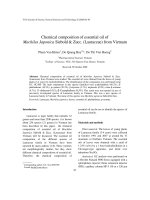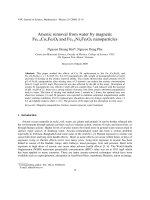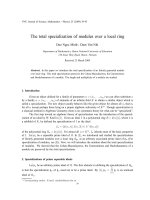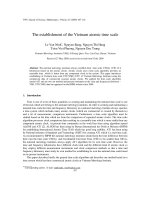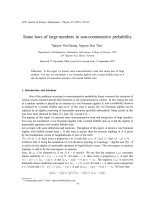Tài liệu Báo cáo " The name of Red River: an evidence of cultural diversity in Vietnam" pptx
Bạn đang xem bản rút gọn của tài liệu. Xem và tải ngay bản đầy đủ của tài liệu tại đây (183.52 KB, 6 trang )
The Third International Conference on Vietnamese Studies
Hanoi. 4-7 December 2008
The name of Red River: an evidence of cultural diversity in Vietnam history
Prof. Tran Tri Doi
Department of Linguistics and Vietnamese Studies
College of Social Sciences and Humanities
Vietnam National University-Hanoi
1. The Red River and its names in history
1.1. The Red River plays a critical role as a spine of historical and cultural life of Ha Noi, the
millennium-civilized capital, as well as of the entire Tonkin Delta. The river’s truck stream flowing
through Ha Noi and its branching distributaries spread out to form a fertile delta: the Red River Delta.
Until now this river has made its appearance with a variety of nominal terms in historical records and
folkloristic traditions. Due to the river’s great importance to the Vietnamese community, its names
present more or less clear reflections of cultural traces belonging to the generator of these terms.
Therefore, a thorough analysis of the differences among the river’s names in origin and formation, to an
extent, will shed some light on cultural diversity of the Vietnamese history at the very cradle of the
national culture.
Figure of the Red River’s sub-basin in Vietnamese territory
1.2. There remains a widely and strongly held view concerning language classification that
Southeast Asia is home to 5 language families, namely Sino – Tibetan, Austroasiatic, Austronesian, Tai
– Kadai, and Miao-Yao [emphasis TTD’s, 1999]. Vietnam regarded as a linguistic miniature of
Southeast Asia is a full convergence of these five families. This framework can serve as a good starting
point to take the Red River’s names into consideration with a hope of identifying their linguistic origin as
well as eradicating their cultural divers. When giving names to the Red River in their own languages, the
inhabitants of the region definitely recorded them in history. For that reason, these toponyms can
provide a strong evidence to confirm the cultural convergence of a specific region like the Tonkin delta
and such a concrete civilization as the Red River civilization, which is one of the main roots leading to
the diversified culture of present-day Vietnam.
1.3. The Red River springs up in China's Yunnan province in the Ailao mountain range. Entering
Vietnam at Lao Cai province, the river flows generally southeastward through Yen Bai, Phu Tho, Ha
Tay, Vinh Phuc, Ha Noi, Hung Yen, Ha Nam, Nam Dinh and Thai Binh before emptying into the Gulf of
Tonkin. Each section of the main channel possesses distinct names. Interestingly, a variety of terms
can refer to the same section in different historical periods, which is overruled by cultural and social
situations. It can serve as a firm foundation to recognize the linguistic derivation and cultural
multifariousness of these river names.
1.3.1. Vietnamese historical documents [QSQTN, t4 (1997), 254], [NVS, (2003) 349] reveal that the Red
River made its mark in old Chinese territory as Lan Thương, Nguyên Giang, Ma Hà (or Lễ Xá), Lê Hoa
and Âu River, and it bore the name of Thao River when flowing into Vietnamese geographical region.
Modern-day geography, however, has demonstrated that Lan Thương is the name of Mekong’s
upstream originating in China rather than the upper course of the Red River as had been shown in
traditional historical records.
1.3.2. The Red River in Vietnamese land has taken on such names as Thao, Nhị/Nhĩ Hà, Phú Lương,
Bạch Hạc, Tam Đới, Đại Hoàng, Xích Đằng, Hoàng Giang and Lô or Lô Giang, which are attested in
classical accounts as follows:
- Thao River[NVS, (2003) 349; QSQTN, Vo.4 (1997), 253].
- Nhị Hà/Nhĩ Hà River [QSQTN, Vo.4 (1997), 256].
- Phú Lương River [QSQTN, Vo.3 (1997), 186]. In fact, this name is cited in An Nam chí lược
(The Concise Records of Annam) by Cao Hùng Trưng.
- Bạch Hạc River [QSQTN, Vo.3 (1997), 186; Vo.4 (1997), 253].
- Tam Đới River [QSQTN, Vo.3 (1997), 186; Vo.4 (1997), 253].
- Đại Hoàng River [QSQTN, Vo.3 (1997), 186; Vo.4 (1997), 253].
- Xích Đằng River Đằng river [QSQTN, Vo.3 (1997), 297].
- Lô River or Lô Giang River [QSQTN, Vo.4 (1997), 253].
These official texts suggest that Phú Lương and Lô or Lô Giang are the two earliest toponyms. The Phú
Lương term arose from Cao Hùng Trưng’s time and had been employed in the reigns of Ly Kings. The
Lô or Lô Giang name came into existence in the Tran dynasty and has been testified in Đại Việt sử ký
toàn thư (Complete Annals of Great Viet). It is also shown that the two river-names display a rather
mutually successive than reciprocally exclusive order in history.
In addition to these documented terms, another name for the River which comes from oral
tradition is Cái River. Since the French colonial period, it has taken the name of “rivière rouge” (Red
River) on account of the reddish-brown heavily silt-laden water. As a consequence, we have solid
grounds for supporting that the currently widespread name Hồng or Hồng Hà came along in the XIX
century.
2. In brief, the Red River has been labeled with 10 different toponyms (and their allonyms) for
its written and verbal identifications, which fall into three major divisions in terms of naming method and
origin.
2.1. The toponyms depicting the river’s peculiarities such as Cái, Thao, Nhĩ Hà/Nhị Hà and Hồng/ Hồng
Hà bound together as the first type.
- Cái River means “Primary River” in a literal sense, whose proprietors are Austroasiatic
speaking people. This specific noun is compatible with a number of Vietnamese basic words: “ngón tay
cái” [the thickest finger = thumb], “đường cái” [high street], “sông cái” [main river], “cầm cái” [to be a
banker (in card games)], etc. It is pretty easy to see that the river was identified by dwellers due to its
vital role in the Tonkin Delta.
- ThaoRiver, a Tai-Kadai originating term, also functions as a way for expressing “the Principal
River”. Socio-linguistically, too, Nghe An province shows tremendous similarities, where The Tai people
called Cả River (a.k.a Lam River) “nặm Pao” meaning “the chief river”. (In the conference on Flower Tai
language and culture held by Yunnan Institute of Social Sciences in Xinpingautonomouscounty, Yuxi
city, Yunnan province in 2000, we observed that the Tai people in Xinping gave name to the Red
River’s upstream in Chinese territory as “nặm tao” referring to “the main river of the region”).
- Nhị Hà/Nhĩ Hà River (or Nhị/Nhĩ River) is considered to date back to the Ming Dynasty after
invadingGreat Viet. “Đại Nam nhất thống chí (Geography of Unified Great Nam) quoting from “Đại
Thanh nhất thống chí” (Comprehensive Geography of the Great Qing Empire) unequivocally points “The
attribution of the Nhị Hà name may have risen from the ground that Hoàng Phúc under the Ming
Dynasty paid attention to the helix-shaped river when constructing the Đại La citadel” [QSQTN, Vo.4
(1997), 186]. Obviously, the meander current structure of the Nhị Hà River gives its name in Sino and
then in Sino-Vietnamese form.
- Hồng/Hồng Hà means “the red-water river”. From “Đại Nam nhất thống chí” (Geography of
Unified Great Nam), it has been deduced that the toponym of Nhị or Nhị Hà had been applied to the
river until the middle of the XIX century. When occupying Vietnam, to serve the need for river-name
textualization, the French opted for the peculiarity of red water as priority and recorded it in their own
language. There, meanwhile, still remains another point of view, though in a preliminary fashion, that
the term of Hồng/Hồng Hà is produced by the Sino or Vietnamese possessors. It, however, seems only
superficially true in this account. We have not found any historical data which provide conclusive proof
of the official existence of this term before the XIX century. Our reasoning gets a further confirmation
from the fact that other Sino-Vietnamese names including Nhị Hà, Phú Lương, Lô Giang, Đại Hoàng
and the folkloristic name of Cái River had been popularly used at that time. For these arguments, we
lean on the position in favor of the French origin of the Hồng/Hồng Hà name.
2.2. The second type relates to the Sino or Sino-Vietnamese toponyms indicating the geographical
areas through which it flows, including Bạch Hạc, Tam Đới, Xích Đằng and Đại Hoàng:
- Bạch Hạc used for the river’s section at the Bạch Hạc confluence, where the rivers of Red and Đà
meet, is certified in “Đại Nam nhất thống chí” (Geography of Unified Great Nam) [citing from “An Nam
Chí Lược” (The Concise Records of Annam) by Cao Hùng Trưng]: “Phú Lương River (alias Lô River) in
Đông Quan district, Giao Châu prefecture, encounters Bạch Hạc River (Tam Đái county) at its upper
stream, flowing eastwardly through Đại Hoàng River (Lý Nhân district) before discharging into the
sea”[QSQTN, Vo.4 (1997), 186].
- Tam Đới River, according to “Đại Nam nhất thống chí” (Geography of Unified Great Nam), is
named after Tam Đái/Đới county where the river moves along. This classical text explains: “Being laid
down by ancient custom, the river has been named for each partial chunk – for instance, … the
segmentation at Bạch Hạc confluence is known as Tam Đới River, …” [QSQTN, Vo.4 (1997), 253].
- Xích Đằng has been employed for the section of river in Đằng Châu region. Ample assertions can
be drawn from “Đồng Khánh địa dư chí” (Geography of Đồng Khánh): “The chief river, namely Nhị Hà,
is also known as Xích Đằng, which is the river flux in Khoái Châu” [QSQTN, (2003), 251]. “The prolong-
history region Khoái Châu (located in present-day Hưng Yên province) is famous for such toponyms as
Đằng Châu Temple, Xích Đằng Estuary, being a precious reservoir of all generations and holding an
indispensably strategic position” [PHC (1960), 80].
- Đại Hoàng (or Hoàng Giang) is exclusively used for the river’s segmentation from Hưng Yên to the
Hoàng Giang confluence (or Vường confluence) of the two rivers of Hồng and Trà Lý, through Lý Nhân
district before flowing into the sea [QSQTN, Vo3 (1997), 340].
It is interesting to note that the second-type river-names are widely used in texts and documents. It
is the usage restriction, we realize, that reflexes their exotic origin as Sino-Vietnamese terms.
2.3. The other type of names consisting of Phú Lương and Lô/Lô Giang cannot be beyond the
scope of study. These Sino or Sino-Vietnamese terms are named after neither the river’s characteristics
nor the geographical regions through which it runs. As transparently represented in the authorized
historical records, they, however, are the oldest and the most official and oft-cited terms in history. It
seems to us that their archaic-ness and their exclusion from the two previous types hold promises from
historical linguistic perspective.
Some recently declaimed accounts on originations of river-names in particular and toponyms in
general by linguists including TTD (2001), (2005) lend us strong grounds to believe that Phú Lương and
Lô Giang are possible outcomes of the Sinicization and then Sino-Vietnamization process of
Austroasiatic-originating words. In other words, Phú Lương and Lô Giang are formally Sino or Sino-
Vietnamese, but semantically are Vietnamese indigenous names.
3. In the following section, particular emphasis is laid on proofs for the Autroasiastic origin of the
two toponyms Phú Lương and Lô Giang.
3.1 In the first place, a remarkable feature can be observed in patterns of Vietnamese place-names
that some disyllabic Sino and Sino-Vietnamese terms have equivalent monosyllabic original-
Vietnamese nominal words (also known as Nôm toponyms) [TTD (2005)]. Note also, only one of the two
syllables of Sino and Sino-Vietnamese toponym has historically phonetic (and lexical in some cases)
relationship with the Nôm word. The historically phonologic closeness can be taken as a reasonable
indication of indigenous-Vietnamese sources of these Sino or Sino-Vietnamese names. The following
pairs are supposed to be reliably indicative of this correspondence:
Indigenous-Vietnamese Sino-Vietnamese
Rum (River) Lam Giang
Mọc (Village) Nhân Mục
Chèm/Trèm (Village) Từ Liêm
Chấp (Village) Cá Lập
Trầu (Village) Phù Lưu
Etc.
Thoroughly considered, the Vietnamese phonological history shows us that the above indigenous-
Vietnamese syllables namely Rum, Mọc, Chèm/Trèm, Chấp and Trầu display a undeniable phonetic
connection to such Sino syllables as Lam, Mục, Liêm (Từ Liêm), Lập (Cá Lập) and Lưu (Phù Lưu) [NTC
(1989), (1995)].
The same logic can be equally utilized for Phú Lương and Lô Giang, where one syllable in the
disyllabic form is a fuller account of native-Vietnamese origination.
3.2. When considerations have been taken carefully, Lương (Phú Lương) and Lô (Lô Giang) are
possibly the present-day reflexes of the older forms in Austroasiatic languages.
3.2.1. In respect of the Lô Giang term, Giang is apparently a Sino component referring to “river”,
and then the entire word Lô Giang designates literally “Lô River”. Despite being Sino-bearing form, the
first syllable Lô, therefore, may resolvedly descend from a river-denoting Austroasiatic ancestor. Further
evidence can be gleaned from other original-Vietnamese hydronyms. As have been known, Lô River is
the contiguity of Thao River to constitute the main channel of Red River. There still exists such phonetic
variants of Lô as La (La River in Hà Tĩnh and other regions), Rào (rào Quán in Quảng Trị; rào Nậy, also
called Gianh River, in Quảng Bình; cửa rào, the meeting place of Nậm Nơn’s river mouth and Cả River
in Nghệ An; and so on), which all share the same meaning “river”.
Under Vietnamese phonological rules, lô ~ la ~ rào are probably derived from the identical root. The
historical equivalence between lô ~ la is transparently recognized for the common liquid initial sound l
and the similar front vowels ô ~ a (except a minor difference in vowel’s wideness). The correspondence
between lô/ la ~ rào, though dimly realized, is still sufficiently indicative of a diachronic relationship. In
terms of onset, the change of [l] into [r] is a general phenomenon in Vietnamese (lim ~ rim, lâm ~ râm,
lầm ~ rầm, long ~ rồng, lè ~ rè, etc). In terms of rime, the equivalence between a single rhyme
(comprising of one vowel) and a double rhyme (consisting of a vowel and a semi-vowel coda) has been
highly supported from the following dialectal pairs of words:
Northern Dialects North-Central Dialects Meaning
tru trâu buffalo
trù trầu betel
gú gấu bear
gi giây second, moment
chí chấy louse
mi mày you (informal)
A dialect geographical study, consequently, lends further weight to the view that preference is given
to their historically phonetic and lexical familiarity. La/lô/rào are likely to be younger evolutions from the
same obsolete form *lo (meaning ‘river’), whose substitution forms can function as the specific element
(Lô River, La River, Lô Giang River) or the generic element rào (rào Quán, rào Nậy, rào Con in Hà
Tĩnh) in some contemporary toponyms. Given Vietnamese dialectal features and Southeast Asian
language families’ geographical scope, we have a well-founded conclusion about the Austroasiatic-
originating ancient [*lo].
3.2.2. Regarding Phú Lương toponym, the situation is moderately different. The historically phonetic
link hereby attaches to the second syllable Lương, which is the modern-day heir of the original
Austroasiatic form [*kl ŋ/kr ŋ]. It may be more than coincidental that Lươngmakes its mark in a chain of
hydronyms as follows: Hiền Lương/Minh Lương River (alias Bến Hải River), Lương Stream (Vĩnh Linh)
in Quảng Trị; Lương River (or Chu River) in Thanh Hoá, Phú Lương River in Thái Nguyên, etc. There
are also adequate cues to permit the writer to infer with considerable certaintythat Lương bears a
comparative similarity to such other words as long (Hoàng Long River, Ninh Bình), công (Công River,
Thái Nguyên), rông (Đắc Rông River, Quảng Trị) and rằng (Đà Rằng River, Phú Yên).
The Vietnamese phonological history conclusively proves that the evolution from Autroasiatic
[*kl ŋ/kr ŋ] to its phonetic variants is a rule-governed practice. Admittedly, sông (designating river in
general)is the first regular replacement form of *kl ŋ/kr ŋ [HTC (1964)], officiating as the generic
element of nominal complexes like sông Hoàng Long, sông Phú Lương, sông Lam Giang. It appears to
be identical to the development from [*lo] to rào (rào Nậy; rào Thanh, namely Bến Hải River; rào Con)
[For a comprehensive account, see NTC (1995)].
The second variant of the archaic [*kl ŋ/kr ŋ] is intimately associated with phonetic forms lương,
long, công, rông, rằng, which are dissimilar at first glance but historically satisfactorily related.
Respecting initial consonant, the substitution of [l] with [r] and the internal disintegration *kl/kr into [l], [r]
or [k] are fully in accordance with Vietnamese phonetic transformation rule. Concerning rhyme, the
correspondences [oŋ] (ông) ~ [ ŋ] (ong) ~ [ăŋ] (ăng) are normal practice in Vietnamese. The
equivalence between [oŋ] (ông) ~ [ ŋ] (ong) ~ [ăŋ] (ăng) and [ əŋ] (ương), though vaguely recognized
due to the different vowels, are still historically explainable. It is the popularity of parallel-functioning
expressions in Vietnamese: giong buồm/giương buồm, đàng/đường, màu hồng/ màu hường, náng
thịt/nướng thịt, nói ngọng/nói ngượng, trọng nghĩa/trượng nghĩa that convincingly demonstrates the
dualizability of vowels [o, , ă]. All the above arguments lend further weight to the viewpoint that
[*kl ŋ/kr ŋ] is the true ancestor of contemporary formations lương, long, công, rông, rằng.
In the final analysis, these results represent a solid affirmation about the Austroasiatic orign of the
component lương (Phú Lương). It is the consequence of Sinification or Sino-Vietnamization treatment to
the indigenous-Vietnamese ancient name, which is probably reconstructed as [*kl ŋ/kr ŋ] meaning
‘river’. Some explanation for this hypothesis can be proposed from a historical perspective. In the
Chinese dominant period, the Hán officials initially used Hán scripts to record indigenous-Vietnamese
names. The Vietnamese people, later, based on Han characters, to modify them into Sino-Vietnamese
archaic toponyms in a creative way. The documentation of Red River’s name as Phú Lương is not an
exception.
4. In summary, the Red River bears 10 toponyms and their allonyms, of which Austroasiatic and
Tai-Kadai originating names arose at the earliest stages of the development. After that, most of these
river-names (except Cái) have undergone the Sinicized and/or Sino-Vietnamized handling process
before shaping into modern-day substitutions.
4.1. In terms of linguistic origin, these toponyms belong to various genealogical strata.
The name Thao < [*taw] referring to a main, principal river is supposed to transmit from Tai-Kadai
languages, which is one of the most primary language families in North Vietnam, as elsewhere in
Southeast Asia. The Tai people making their homes and livelihoods in the spectacular mountains of the
north with a long-history and diversified culture, left their traces in Red River’s name.
Austroasiatic-originating hydronyms, in the mean time, reveal much more multifaceted issues. The
toponym of Cái is also named after the essential role of the river in inhabitants’ life. Obviously, the same
naming method of Thao and Cái is a reflection of similar reality-mapping structure of Tai and
Austroasiatic dwellers. This can be taken as a compelling indication of the two names’ earlierness in
comparison to other terms.
The two names of Phú Lương and Lô Giang, on the contrary, has gone a process of extreme
change. Lương and its variants long, công, rông, rằng may be originated from the obsolete [*kl ŋ/kr ŋ].
This reconstructed form possibly had shifted its function from a general noun denoting “river” to the
specific element of a toponym, and then was Sinificated before shaping the present-day Phú Lương.
Similarly, Lô/ la/ rào are probably reconstructed as [*lo], which initially means “river”. After Sinicization,
this common noun became the simplex “Lô River” or its dissyllabic variant “Lô Giang River”.
4.2. Through systematic analysis and comparison of formation and origin of the Red River’s names,
we come to the following conclusions about an interesting cultural phenomenon.
In age-descending order, the two Austroasiatic originating names Phú Lương and Lô Giang may be
first ranked, the Tai-Kadai term Thao and the Austroasiatic name Cái stand on the second position, and
the last is Hồng/Hồng Hà. Furthermore, as the outcome of a modification from a general noun to a
proper noun, Phú Lương and Lô Giang are likely to be more ancient than such toponyms naming after
the river’s features as Thao and Cái. Phonetic transformation and semantic change reinforce each other
in indicating the linguistic originsof these toponyms.
From cultural angle, the Red River is a conduit of mutual influence between Austroasiatic and Tai-
Kadai speaking inhabitants when the river seems to be the Southwestern boundaries of Tai-Kadai
geographical distribution. The Austroasiatic and Tai-Kadai toponyms, then, had passed through a
process of Sinicization and Sino-Vietnamization. In conclusion, the Red River’s names serve as a solid
evidence of the cultural convergence or harmony of differently-originated inhabitants in history.
REFERENCES
1. Đào Duy Anh (1997), Đất nước Việt Nam qua các đời (A geographical and historical study of
Vietnam), Nxb Thuận Hoá, Huế 1997, p. 263.
2. Nguyễn Tài Cẩn (1989), Nguồn gốc và quá trình hình thành cách đọc Hán - Việt (Origin and
formation process of Sino-Vietnamese prounuciation), Higher Education and Vocational Secondary
Schooling Publisher Nxb ĐH&THCN, Hà Nội ; reprinted VNU Publisher Nxb ĐHQGHN (2000), Hà Nội,
p. 354.
- (1995), Giáo trình lịch sử ngữ âm tiếng Việt (Sơ thảo) Textbook on Vietnamese phonetic history
(Preliminary part), Nxb Giáo dục, Education Publisher, Hà Nội, p.348.
- (2001), Một số chứng tích về ngôn ngữ, văn tự và văn hoá (Some linguistic, documented and
cultural evidences), Nxb ĐHQG Hà Nội, p.439.
3. Hoàng Thi Châu (1964), Mối liên hệ về ngôn ngữ cổ đại ở Đông Nam Á qua một vài tên sông,
Thông báo khoa học, Đại học Tổng hợp Hà Nội, Ancient Linguistic Linkage in South East Asia as
Evident in Some River Names, Research Newsletter, Hanoi University,Vol. 3: 94-106.
4. Phan Huy Chú (1960), Lịch triều hiến chương loại chí (Settlements of matters by the successive
dynasties), Vo. 1, Nxb Sử học, Hà Nội, p. 352.
- (1997), Hoàng Việt địa dư chí (Geography of Hoàng Việt) , Nxb Thuận Hoá, Huế.
5. Trần Trí Dõi (1999), Nghiên cứu ngôn ngữ các dân tộc thiểu số ở Việt Nam (A study of
Vietnamese minority languages ), NXb ĐHQG Hà Nội, p. 301.(second edited 2000)
- (2001), Ngôn ngữ và sự phát triển văn hoá xã hội (Language and Socio-cultural development),
Nxb Văn hoá Thông tin (Information and Culture Publisher), p. 266.
- (2005), Giáo trình lịch sử tiếng Việt (sơ thảo) (Textbook on the history of Vietnamese language)
(Preliminary draft), Nxb Đại học Quốc gia Hà Nội, Hà Nội 2005, p.268.
- (2005),Tiếp tục tìm hiểu về xuất xứ và ý nghĩa địa danh Cổ Loa (Further investigation of the origin
and meaning of the Cổ Loa toponym), Ngôn ngữ 11(198)/11-2005: 21-27.
6. Ngô Sỹ Liên (1998), Đại Việt sử ký toàn thư (Complete Annals of Great Viet), Nxb Khoa học xã
hội (Social Sciences Publisher), Hà Nội 1998.
7. Quốc sử quán triều Nguyễn (1997), Đại Nam nhất thống chí (Geography of the Unified Great
Nam), Nxb Thuận Hoá, Huế 1997, Vo. 3, Vo. 4.
8.Quốc sử quán triều Nguyễn (2003), Đồng Khánh dư địa chí (Geography of Đồng Khánh) , Nxb
Thế giới (World Publisher), Hà Nội 2003.
9. Nguyễn Văn Siêu (1997), Đại Việt địa dư toàn biên (Comprehensive Geography of Great Viet),
Nxb Văn hoá, Hà Nội.
- (2003), Phương Đình dư địa chí (Geography of Phương Đình), Nxb Thế giới, Hà Nội 2003.
10. Ngô Thì Sỹ (1997), Đại Việt sử ký tiền biên (Preliminary Record of the History of Great Viet),
Nxb Khoa học xã hội, Hà Nội 1998.

